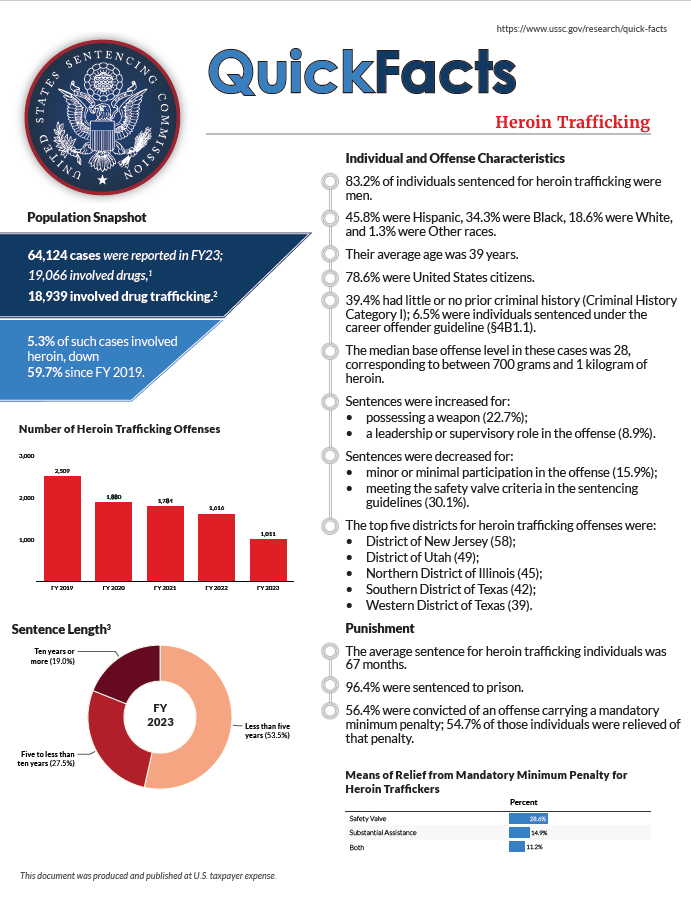Of the 61,678 cases reported to the Commission in fiscal year 2024, 18,150 involved drugs.1 Of those, 18,029 cases involved drug trafficking;2 3.3% of such cases involved heroin (down 68.1% since fiscal year 2020).3
Click the cover for the PDF handout or learn more below.
Individual and Offense Characteristics
- 85.4% of individuals sentenced for heroin trafficking were men.
- 58.1% were Hispanic, 28.2% were Black, 12.2% were White, and 1.5% were Other races.
- Their average age was 39 years.
- 75.0% were United States citizens.
- 40.7% had little or no prior criminal history (Criminal History Category I); 5.3% were individuals sentenced under the career offender guideline (§4B1.1).
- The median base offense level in these cases was 30, corresponding to between one and three kilograms of heroin.
- Sentences were increased for:
- possessing a weapon (24.8%);
- a leadership or supervisory role in the offense (10.5%).
- Sentences were decreased for:
- minor or minimal participation in the offense (16.8%);
- meeting the safety valve criteria in the sentencing guidelines (34.6%).
- The top five districts for heroin trafficking offenses were:
- District of New Jersey (45);
- Southern District of Texas (41);
- Western District of Texas (34);
- District of Utah (34);
- Northern District of Illinois (23).
Punishment
- The average sentence for individuals trafficking heroin was 66 months.
- 95.2% were sentenced to prison.
- 51.8% were convicted of an offense carrying a mandatory minimum penalty; 54.8% of those individuals were relieved of that penalty.
Sentences Relative to the Guideline Range
- 56.7% of sentences for heroin trafficking were under the Guidelines Manual.
- 25.6% were within the guideline range.
- 25.1% were substantial assistance departures.
- The average sentence reduction was 62.5%.
- The average sentence reduction was 62.5%.
- 1.7% were Early Disposition Program (EDP) departures.4
- The average sentence reduction was 58.1%.
- The average sentence reduction was 58.1%.
- 3.7% were some other downward departure.
- The average sentence reduction was 43.6%.
- The average sentence reduction was 43.6%.
- 0.5% were upward departures.
- The average sentence increase was 90.4%.
- The average sentence increase was 90.4%.
- 25.6% were within the guideline range.
- 43.3% of sentences for heroin trafficking were variances.
- 41.3% were downward variances.
- The average sentence reduction was 45.0%.
- The average sentence reduction was 45.0%.
- 2.0% were upward variances.
- The average sentence increase was 135.8%.
- 41.3% were downward variances.
- The average guideline minimum and the average sentence imposed have fluctuated over the past five years.
- The average guideline minimum was 90 months in fiscal year 2020 and 101 months in fiscal year 2024.
- The average sentence imposed was 66 months in fiscal year 2020 and fiscal year 2024.
- The average guideline minimum was 90 months in fiscal year 2020 and 101 months in fiscal year 2024.
1 Drug offenses include cases where individuals were sentenced under USSG Chapter Two, Part D (Drugs). There were 602 individuals sentenced for heroin offenses under USSG Chapter Two, Part D (Drugs) in FY 2024.
2 Individuals sentenced for drug trafficking were sentenced under USSG §§2D1.1 (Drug Trafficking), 2D1.2 (Protected Locations), 2D1.5 (Continuing Criminal Enterprise), 2D1.6 (Use of a Communication Facility), 2D1.8 (Rent/Manage Drug Establishment), 2D1.10 (Endangering Human Life), or 2D1.14 (Narco-Terrorism).
3 Cases with incomplete sentencing information were excluded from the analysis.
4 “Early Disposition Program" (or EDP) departures are departures where the government sought a sentence below the guideline range because the defendant participated in the government’s Early Disposition Program, through which cases are resolved in an expedited manner. See USSG §5K3.1.
SOURCE: United States Sentencing Commission, FY 2020 through FY 2024 Datafiles, USSCFY20-USSCFY24.

